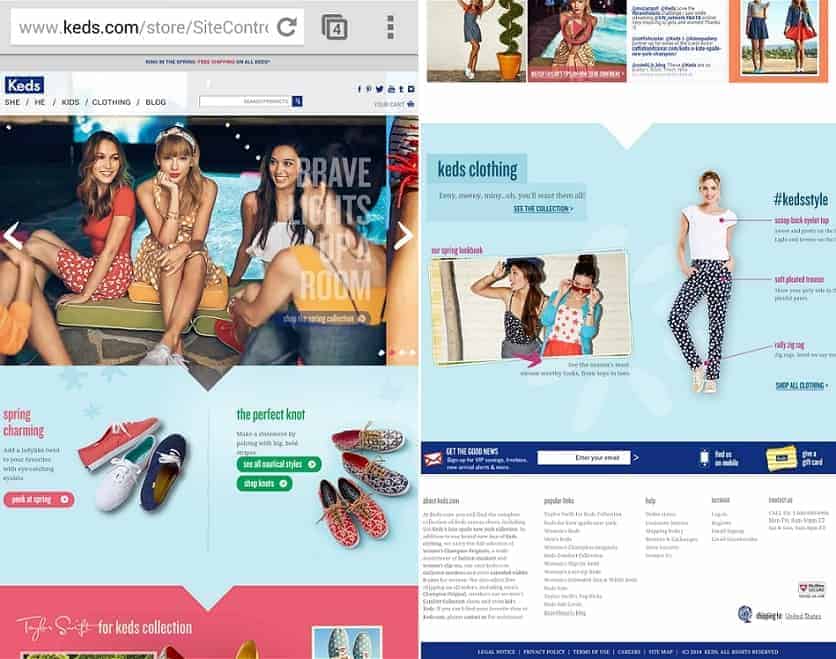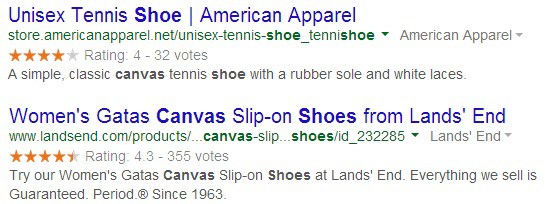A Quick Glance at Keds’ Ranking
I have fond memories of wearing Keds when I was a kid. It’s been a while since I owned a pair, so I took a look in Google to see how the company that was founded in 1916 was doing. Turns out, not so great. I was kind of surprised, as Keds is one of the biggest shoe and sneaker brands in the U.S. In a search for ‘shoes’, Keds did not appear in the top 300 pages listed! And a search for ‘sneakers’ yielded only a 35th place ranking. In just two more years, Keds will turn 100, and I’m concerned that they are falling to the wayside in the fast moving world of SEO and inbound marketing.
And although the Keds site looks sleek, I had a hunch that their technical makeup was flawed. After a quick dive into their site with my co-worker Rachel, we found some pretty big SEO problems whose solutions could significantly help Keds’ internet presence.
Homepage
The homepage of a site is arguably the most important page for any domain, because it accrues strength and equity from all sub-pages and sub-domains. That is why it is important for the homepage to work properly, and ideally return a 200 status code. When I entered Keds.com, it returned a 302 status code, which I found to be rather alarming. In fact, the URL of ‘keds.com’ redirects to a much more complicated homepage URL based on my current location:
While there are no steadfast rules in the construction of a homepage URL, it is basic smarts to keep it tidy and without any parameters. This means it should stay as close as possible to the root domain of http://www.keds.com/. By not having the homepage as http://www.keds.com/, Keds risks losing equity across the board, because if another website were to link to http://www.keds.com/, equity might not transfer to their more complicated http://www.keds.com/store/SiteController/keds/home?locale=en_US_USD due to the “temporary” redirect response code. In general, the closer a homepage is to the root domain, the stronger the domain will be in Google’s eyes. International redirects can work, but they must be done properly, with hreflang tags and much more. That is not the case here.
Let’s Talk Meta Data
The homepage title tag for any site is hugely important, and I thought Keds’ title tag was rather interesting, as it focused on the female market:
Keds Canvas Sneakers For Girls, Teens & Women | Keds.com
I plugged these keywords into the Keyword Planner and compared them to their male counterparts, and there is actually more volume for ‘mens sneakers’ than ‘womens sneakers’.
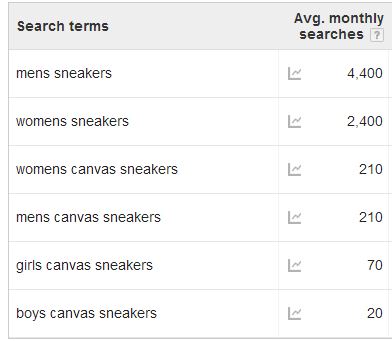
This means that Keds definitely has to put ‘mens’ and ‘boys’ in the title tag, for ranking purposes. Also, traffic and volume aside, I do wonder that if by focusing on women, Keds is hamstringing themselves for the overall keyword ranking for ‘shoes’, in which Google might actually seek out shoe sites which serve both male and female. Although I can’t prove this theory, I do know that Keds has about 13 spare characters in their title tag, with another 4 if they remove the extraneous .com, so there is no excuse not to add in ‘mens’ and ‘boys’. And if you’re worried that Keds will dilute the title tag emphasis on the girls/women aspect by adding in boys/men, I’d counter and say they are not even ranking in the top 75 for ‘girls shoes’, so either way the female focus strategy isn’t really working.
Another title tags issue is the lack of innovation for individual products. Though there are thousands of product pages, it would be quite an arduous task to do proper keyword research for every product page, and likely a waste of time. However, product pages can still be optimized in a formulaic manner. Allow me to explain by checking out the meta data for Rookie Wedge Chambray Stripe shoes:

The title tag contains the name of the product it is representing. That’s a good start. But what about the first half of the title tag: “Keds Shoes Official Site“? Why waste half of the character space on something that offers no value? Furthermore, those 4 words dilute the weight that is given to “Rookie Wedge Chambray Stripe“, which should certainly be in the first part of the title tag and not the latter. For a big brand like Keds, there is no reason to waste so many characters on the brand, when it could just say Keds Shoes.
Another issue is that the title tag here is identical to another product page title tag seen here. The difference between the two are the colors of the shoes, but Google probably doesn’t know that because their title tags are the same, and this ultimately dilutes the ranking for each page. An easy fix would be to automatically construct the title tag across the board for all product pages by leading off with the same structure: a concise brand mention, name of the shoe, and the color. Here is an example of what the title tag should look like:
Keds Shoes | Rookie Wedge Chambray Stripe Shoes – Tan
Another issue is the meta description. As you can see, it weighs in at 83 characters, which is roughly half of what Google allows us to display in the SERPS. We know that Google does not use meta descriptions in how they rank pages, however, internet users, ie human beings, certainly weigh meta descriptions. We read them and decide if we want to click on a page based on what the meta description tells us. The click-through rate opportunity potential is tremendous — if you have an SEO-trained copywriter. The above 83 character meta description is short, vague, and offers no call to action. It should be spiced up with calls to action, some interesting information, and perhaps a bit of urgency, like such:
Check out Keds’ Rookie Wedge Chambray Stripe Shoes. Currently in tan and blue, & with a secret wedge compartment, they are unlike any other shoe. Buy yours today!
XML Sitemap, Where Are You?
I went and took a gander at the Keds XML sitemap. And, there was a slight problem: it doesn’t exist. (Nice 404 page by the way!). An XML sitemap is essentially a file which acts as a map for Google to look at and understand how to index a site, and gives webmasters an opportunity to tell Google to index certain pages that might not have been indexed previously. Also, when changes are made, the XML sitemap alerts Google immediately, and otherwise could take up to a few days for Google to see changes and index/rank the changed pages properly. Sitemaps are also useful for clarifying a site’s categories, and where pages fall within them. Although Google is not required to abide by a sitemap, it almost always does. For a huge site like Keds, an XML sitemap is imperative.
Mobile Headaches
The mobile site does not seem to redirect properly. When I did a search for Keds on my phone, and clicked on the Keds site, it went to Keds.com rather than the mobile version of the site at m.keds.com. When I accessed m.keds.com/robots.txt to see what was up, I saw that the mobile site was allowed for crawling and even had 45 pages indexed. And yet, it wasn’t redirecting. Although at its core this is a tech issue, it is something very important for mobile SEO, because right now, a mobile user who finds Keds through Google is brought to the non-mobile site, which is much harder to grapple with and toggle on a smart phone. A lot of the text was hard to read unless you zoomed in, as you can see below:
Duplicate Content Risk?
The first thing we learn in SEO is to create great content. I noticed that Keds has the same exact ‘About’ content blurb on what seems like every page of their site. Google does not like duplicate content and certainly doesn’t reward it. Because this blurb contains only 90 words, I’d say that Google probably isn’t penalizing them for duplicate content, however, I am fairly certain that there is zero value given to that content, and certainly no equity in the links that are hidden in it. I think that Keds should simply limit the ‘About’ blurb to their About page, and delete all of that excess duplicate content. And if they insist on keeping some type of explanatory paragraph on each page to guide the user and offer background, then there are ways to do that. They can personalize a lot of these content blurbs and make them relate to the specific content on the page they are on. This could even help individual pages rank for more keywords, depending on the methodology.
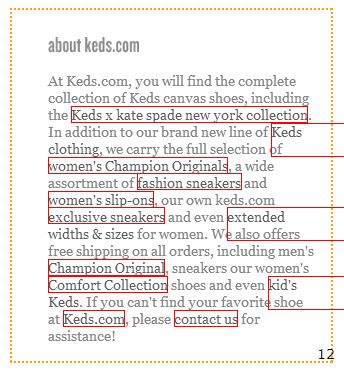
Also, as an aside, the links in the ‘About’ blurb come off as if they are trying to hide them, since they are in a very similar shade of gray to the surrounding text. This likely means that they are intended just for the search engines. Google certainly does not favor any form of cloaking, so I’d advise Keds to either remove the links or change the color so that users can easily see and click them.
Take Advantage of On-Page Content Opportunity
Speaking of content, one core element of on-page content optimization is the presence of key words. That’s right: key words, not keywords. I say that because there are important, relevant words that need to be part of the content construction of any site’s pages. An example on Keds is the fact that ‘shoes’ is mentioned only twice on the homepage! And the two mentions appear in that ‘About’ text blurb which likely offers no ranking value since it appears on almost every Keds page. Now, I understand that Keds’ homepage is filled with nice looking glossy images, but why pass up such an easy opportunity? The word ‘shoes’ is literally shouting at Keds to be placed on the page in a relevant manner. I saw this glaring hole on many pages, and if Keds were a client, my first priority would be to populate relevant content with the right words throughout the site. (Now it becomes more clear as to why Keds.com does not rank in the top 300 for ‘shoes’). Of course, one cannot just throw the word ‘shoes’ onto the page like oily spaghetti at a wall – it has to be done properly in the right context, and should not be abused.
On a similar note, I was puzzled by the lack of optimized headers. Take this shoes page for example. The only <h1> tag on that page is “View All Keds“. Frankly, that’s a waste of an <h1>. And check out these generic <h2>’s: She, About Keds.com, Popular Links, Help, Account, Contact Us. While we don’t fully know the weight given to <h1> and <h2> in Google’s eyes, suffice it to say that they should at least contain relevant keywords, and not generic on-page directives. Why not get the word ‘shoes’ in them? It’s the type of thing that can easily be implemented with no risk, and likely a much higher upside.
Another content quick fix would be to change the alt text for images, at least on the homepage. Right now, each alt text for images features the word sneakers. Why not sprinkle the word ‘shoes’ in there?
Meta Keywords Are Not Recommended
I started working in SEO after meta keywords became extinct. For the page we just discussed, here are the meta keywords listed:
Wow, that’s quite an impressive list! Unfortunately, Google no longer gives any value whatsoever to meta keywords, and, because they became so thoroughly abused, are more likely to be a spam signal than help a page. That is why we always recommend to not list any meta keywords whatsoever if they can be easily removed.
Blog Smarts
Blogs are a hugely useful tool for engaging with audiences, and capturing market share from beyond the e-commerce sphere. When I clicked on the blog, it redirected to a different domain – BraveHearts.com. The obvious issue with this is that Keds is basically giving up on free and easy link equity to their website. If the blog would simply be http://www.keds.com/blog/ or even http://www.keds.com/bravehearts/, then the Keds domain would benefit from any and all of the links and web presence that the blog achieves. And because BraveHearts is essentially its own entity (in Google’s eyes), it may even be siphoning off and leaking link equity away from Keds. It’s a lose-lose situation. If Keds wants to continue to promote the BraveHearts name, they can still do that, by redirecting bravehearts.com to the new blog on http://www.keds.com.
Too Many Indexed Pages
I ran a quick crawl. Or at least I thought it was going to be quick, and then I saw that it was taking over 15 minutes! That’s because Keds has over 1 million pages indexed!

While on the surface Keds might not think it’s a big deal to have over a million pages out there, it’s definitely a problem. For one, it can confuse Google, because there are so many similar pages, that Google probably isn’t sure what to give preference to. This leads to the real problem: many of these similar pages end up competing with each other, thereby hurting the ranking of each individual page. Keds needs to “cut the fat” so to speak, which will give clarity to Google, and allow the top pages to rank highest, with no risk of cannibalism.
I looked into their index bloat and did a search for new arrivals within the Keds domain. Right off the bat, I found two separate URLs for new arrivals being indexed.
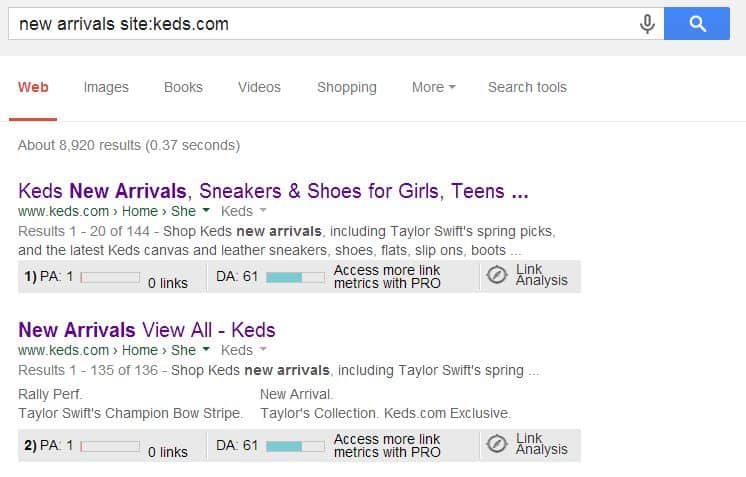
These pages are nearly identical, with the only difference being that one of them shows only 20 pairs of shoes on 1 page, and the other page shows 135 of them. Of course, it is a waste to have 2 pages indexed for the same thing (new arrivals). Instead of having two pages indexed, it should have only one page indexed. Any new URLs that result from choosing to view either 20, 40, or 135 shoes on one page should use a canonical tag to ensure that it is not indexed by search engines. By eliminating all of the excess indexed pages, Google will give more weight to pages that Keds leaves indexed.
Explore Schemas
In a search for ‘shoes’ and ‘sneakers’, there were no relevant results with schema attached. Schema can include product ratings, reviews, authorship, and video snippets. I did a more specific search of “canvas shoes”, and in the first 50 results, there were only two pages with schema:
Even though the majority of shoe & sneaker websites don’t seem to utilize schema, this existence of the two above ones shows that it is indeed possible for this industry, and certainly could be something useful to increase click through rate.
Keds.com Final Analysis
The recommendations above came from a quick 2 hour mini audit of Keds’ website. There are many more things we noticed, and surely more things we can uncover with a deeper analysis. The idea for this article/audit was because I noticed that Keds does not currently rank in the top 300 for ‘shoes’, and is ranked just 35th for ‘sneakers’. ‘Shoes’ has a monthly search volume of 1,220,000, and ‘sneakers’ nets 450,000 searches per month. Imagine how much Keds could increase their revenue once their rankings improved for each of those search terms. Remember, ranking highly for organic search terms is essentially free advertising. Right now, there are at least 300 sites that will appear before Keds does in a search for ‘shoes’. If that can be fixed, then there is a huge growth opportunity.
I was happy to write up this brief analysis because I used to be a big fan of Keds, and I think it’s time that they got back in the mainstream.

